By Roberto Motta and Pete Vack
Photos from Centro Documentazione Storica Alfa Romeo, and Roberto Motta
In doing research for these articles, (Read Part 1) one of our goals was to do something very simple that to our knowledge had not been previously attempted; to put a serial number on each Disco that was in a contemporary photo. After all, there were only five cars built, four still exist, only one had a competition history, we had all the serial numbers and details, and most of the books and articles, access to the Alfa Museum. What could be simpler? But the more we looked, the deeper the mysteries.
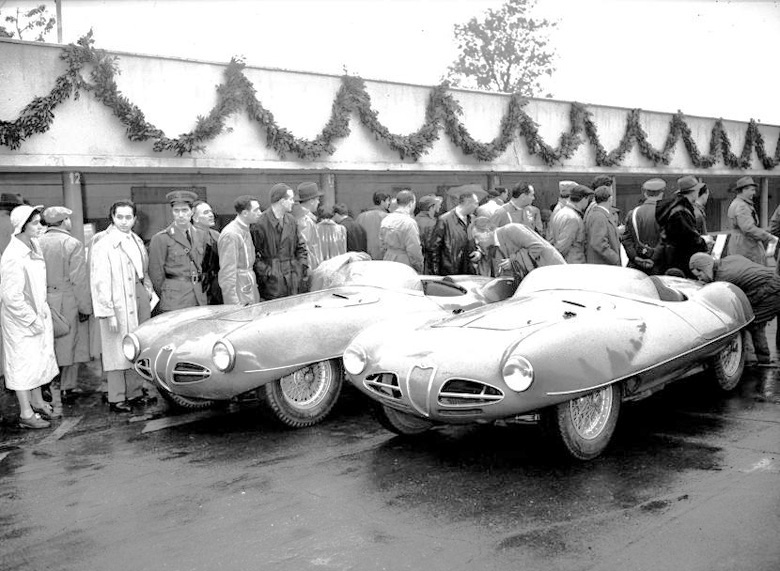
The date is October 2, 1952. There are two Disco Volantes in this photo. Presumably the car closest to the camera is the 3 liter, as the exhaust is routed out the left side of the car ahead of the rear wheel. The other may be a 2 liter. But we can’t tell you the serial numbers of each car with any degree of certainty. Now, note the different headlights on each car; the 3 liter sports a thinner ring with European style lights.
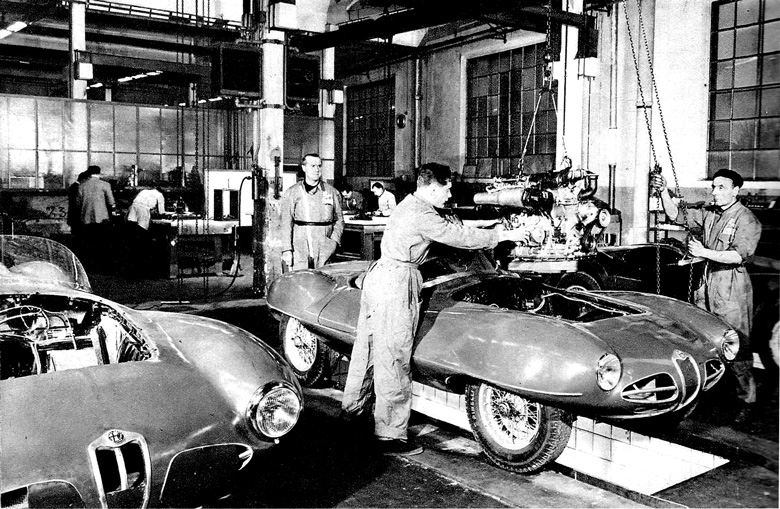
Just to confuse, in another photo taken at about the same time, we see three Discos. Almost totally hidden at the rear is AR1359*00002, the ‘fianchi stretti’. At the right is a car very similar to the 3 liter model in the above photo, with exactly the same type of headlight. The catch is that the engine over the car is a 2 liter unit, but we can’t really tell if the engine is coming out or going in! The car on the left is anyone’s guess but look at the headlight.
One of the first to identify the Disco Volante series was Alfa expert and author of The Immortal 2.9, Simon Moore. In the January 1976 (yes, forty two years ago!) Moore had his summation of the history of the Disco Volante series published in Thoroughbred and Classic Cars magazine. He listed the serial numbers of the 2 liter cars, the two 3 liter cars, and the eight 1953 “AR 3000 CM” Alfas constructed after the demise of the original Disco Volante program. This list has held up very well, and also used for CF Anderloni’s Alfa Disco Volante book in 1993.

In 1952 the Discos were subjected to a number of tests at Monza. The car in this photo has been previously identified as a 2 liter car. However, one of the main differences between the 2 liters and 3 liter variation was the routing of the exhaust pipe. The 3 liter had it routed out the side. So is this a 2 liter with a revised exhaust system?
The 3000CM series is beyond the scope of this article, but not so the two 3 liter cars built as ‘real’ Disco Volantes in 1953. Sorting them should be easy.
The first number was AR1361*00011. Note the 1361 prefix as differentiated from the 2 liter 1359. It is an assumption that this was the first 3 liter car constructed, but some sources, including Anderloni, clearly state that the first 3 liter car was a modified 2 liter. But what was the original serial number as a 2 liter? If so there would have to have been four AR 1359 cars built, not three. The car was kept by Alfa until it was given to the Biscaretti Museum (now the Museo dell’Automobile) in Turin in 1969. Furthermore, this car was given a special 3.5 liter engine, not a 3 liter.
1362*00012 All we know of 00012 is that it was a Disco type 3 liter and ‘dismantled’ by the factory, no date given. Note, however, the designation has changed from 1361 to 1362. We don’t know if this car was given a 3 liter or 3.5 liter engine. Is this the missing Disco Volante, or did it become the first of the famed 6C3000 CM cars? (See below).
In Search of the Disco Dashboards: Pedantic, Compulsive, Arcane, Obscure and Downright Silly
June 1952, Monza
Many of the photos we were interested in attaching a serial number to were taken at the Press introduction of the Disco Volante in June, 1952 (we have yet to nail down the specific date) and others undated, at various test sessions at Monza. One might assume that the 3 liter car shown in the Disco introduction in June photos was 1361*0001. But don’t bet a caption on it. That car could have been AR1362*00012.
Since 00011 still exists, logically one might compare the contemporary photos to ones taken of the car while at the Turin Museo Dell’Automobile and determine if certain details could be seen on each car. While the bodies themselves were almost all identical between the four or five Discos, other details were different, such as the design of the dashboard. Fortunately, we have photos of the dashboard of the 3 liter at Monza in 1952 and the 3 liter at the Turin Museum as it appears today. One might assume that there would be no significant changes in the style, shape or pattern of the dashboard, and if the Monza car’s dash was identical to the Turin car dash, we could safely assume that the Monza 3 liter Disco was 1361*00011. Right?
A cursory glance indicated that the two dashboards were identical. But look again. They are not. Which means that either someone, for some reason, at some time, made a slight and rather unnecessary design change in the dashboard, or the two cars were different cars entirely, and perhaps the Monza 3 liter is actually 00012, since we don’t know when the car was ‘dismantled’.
In either event, it meant that we could not state with a 90 percent certainty that “Here is the 3 liter version being driven by Sanesi. It is s/n 1361*00011 which is now in the Turin Museum.”
Maybe the Turin Museum, officially the Museo dell’Automobile, had something in their files that we overlooked. So Roberto Motta sent off an email to Paola Masetta at the Museum. Can they confirm that the Alfa Disco Volante, AR 1361*00011, now in their museum, is the same car as tested by Sanesi at Monza in June, 1952? He promptly received an answer:
“Good morning Roberto,
Regarding the use of this car by Sanesi in the tests in Monza in 1952, we did not find any documentation in our archive; you should check on the publications of the time. I remain available and greet you cordially, Paola Masetta”
We can’t blame them; no one was paying a great deal of attention to odd prototype serial numbers in 1952 so there was probably no smoking gun in the archives. But at least we checked. Previously, Motta had also discussed this with the Alfa Romeo Museum, but to no avail.
Ok we concede. We can’t nail down the two three liter cars with any certainty. But what about the three 2 liter cars? As stated last week, it is probable that 00002, the ‘fianchi stretti’, was never bodied as a Touring Disco but numbered out of sequence. Scratch AR1359*00002. The coupe, on the other hand, probably did exist as a Touring Disco before getting a tintop. But we have no photos of the car as a spider with serial number identification AR1359*00003.
That leaves us back at square 00001. Can we confirm that the 2 liter Disco that appeared at Monza was 00001, the very car now in the Alfa Museum? Perhaps. Given that the dashboard as it appeared in 1952 is virtually identical to the dashboard as it appears today, and all other details are similar, we can say with 90 % certainty that it is the same car.
The catch is that we now realize that the lines, (style, symmetry, etc) of the dashboards were changed at will for no particular reason at times undetermined. This then could be the case with 00001 as well. Furthermore, the differences in the two dashboard designs meant that we probably couldn’t use dashboards as an identifier. This made us take a closer look at the dashboards on all available images.
Watching the curves
In the montage above, the first set of photos indicate the dashboard difference between the 3 liter Monza car at left and the car in the Turin Museum today (courtesy Millenove Alfa Romeo 1900). Watch the curves. This one is particularly disconcerting as it has always been assumed that the Sanesi car at left was indeed AR 1361*00011. But the dashboards are different; somewhere along the long and winding road someone revised the dashboard, or they are two different cars.
In the second group, we have photos of the Disco sent to the NYC International Auto Show in 1953; Anderloni, who was there, says this is a 2 liter car but no serial number given. Is it 00001 or could it be 00002, the coupe as a spider? And if one might have thought that Alfa used just one show car to send to all of the year’s shows, think again. At the right is a photo of the Disco Volante at the Geneva Auto show. It was stated clearly that this is a 3 liter Disco. But the dash is not the same as 00011. Could it be 00012?
And that last photo in the montage: The dashboard of 00001 is identical to the Monza 2 liter, giving us our 90 percentile of certainly; see photo below. But after finding five different dashboard configurations, we have given up hope of ever claiming we can identify these unidentifiable flying objects by serial number.
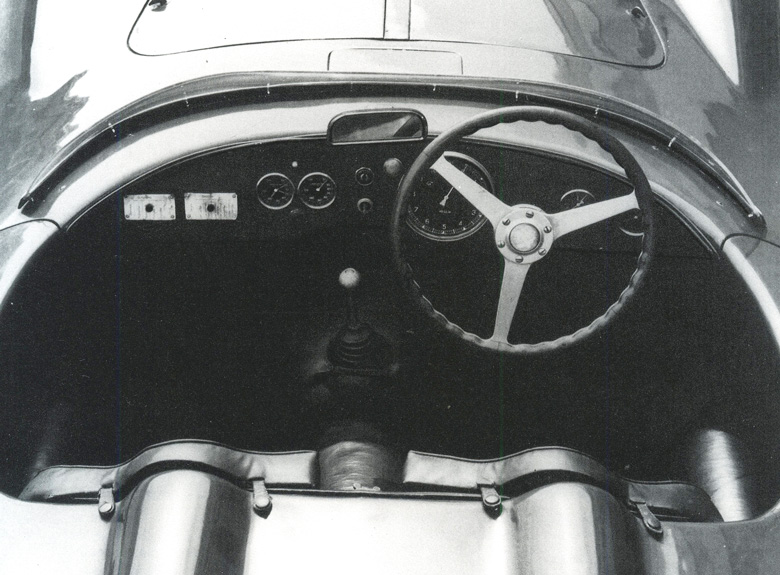
At Monza, the 2 liter car appeared with this dash configuration, virtually identical to 00001 in the Alfa Museum today.
We can’t leave well enough alone. Since we are on the subject of Disco dashes, and have shown our readers the five different styles of dashes found on the Disco spiders, one might wonder what the dashboard layout was on the coupe and ‘fianchi stretti’ cars. So why not:
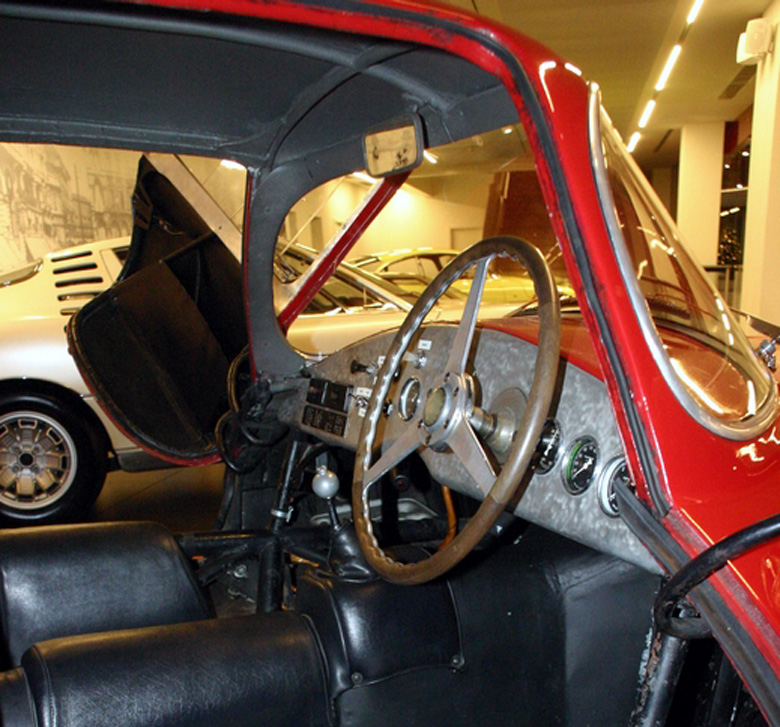
The Disco coupe dash configuration is close to the one in 00001 but in unpainted aluminum. Roberto Motta photo.
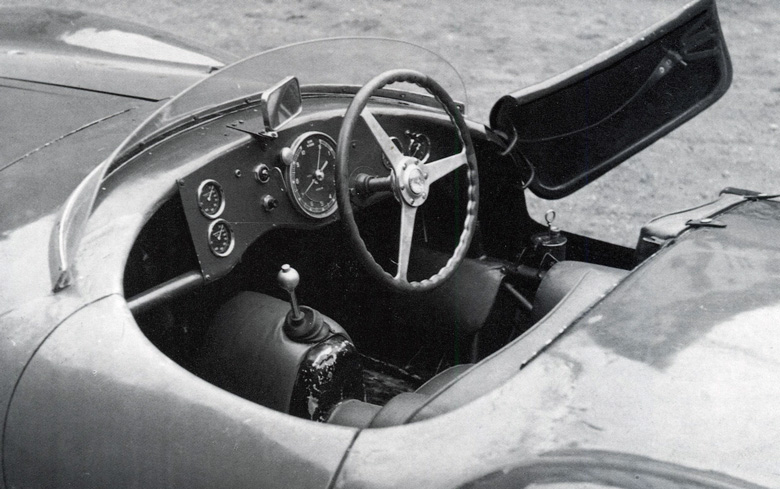
Of course the ‘fianchi stretti’ car was a completely different design, but there are similarities in the design of the dashboard.
So, we learn that tracking serial numbers but using key design elememts is often difficult and leads to hasty conclusions, an object lesson for future and present Italian car serial number hunters. We are eager to hear from other Alfa enthusiasts and historians on the subject.
*The bronze statue ‘Disco Volante’ is found in the Milan city’s Fair in Rho. It was unveiled for the celebration for the centenary of Alfa Romeo in Milan in 2010. Commissioned by the Italian Alfa Romeo Register (Riar), http://www.alfaregister.net/ the idea of a monument was studied by the Alfa Romeo Style Center. Milanese architects Monica Mariani and Claudio Lo Paso outlined its structure by designing an appropriate base, a plaque with historic Alfa Romeo milestones. Finally, the famed Milanese sculpture Agostino Bonalumi gave his personal contribution to the difficulties of balancing the two elements and refining the lines of the bronze model, resulting in the curved and sweet lines of the “Disco Volante.” –Roberto Motta
Tracking the REAL Discos
AR1359*00001 remained in spider configuration with the 2 liter engine. Now at the Alfa Romeo Museum.
AR1359*00003 was transformed into a closed bodywork coupe with a 2 liter four. Now in the Alfa Romeo Museum in Arese.
AR1359*00002 Another spider, but the line of the body was thoroughly revised. The lenticular profile was abandoned and the body took the more conventional form, nicknamed ‘fianchi stretti’ or ‘narrow sides’, which significantly improved its handling. Moreover, its engine was equipped with a new feeding system with 4 horizontal carburetors single body. After a brief competition career it was bought by the Neapolitan pilot Luigi Bellucci and returned to Italy to be purchased April 3 1963 by Fritz Schlumpf. From that moment it became part of the Schlumpf collection at the Cité de l’Automobile in France.
The ‘Disco Volante’ 3000
AR1361*00011 In anticipation of participation in ’53 Sport World Championship with Juan Manuel Fangio, was built a new frame identified with the number AR1361*00011, for the ‘Disco grande’ or ‘big Disco’. The car was equipped with the 6 cylinders engine of 3 liters (82.55 x 92 = 2954.358 cc) that had a compression of 8.1: 1, was fed with 3 twin choke Weber carburetors and developed maximum output of over 240 hp 6500 rpm. Besides the new engine, the wheelbase was extended to 2420 mm with a weight of 760 kg. Aesthetically, it was similar to the sister of lower capacity and had slight differences in the dashboard, in the back where the cap for gasoline was outside, and it had two lateral outlets on the left side. It was tested by Sanesi at Monza, but never participated in competitions. AR1361*00011, with the 6C 3000 CM engine, a 3.5-liter, six-cylinder Type 1311′, is preserved in the ‘Museo Nazionale dell’Automobile’ at Torino.
AR1362*00012 According to Carlo Felice Bianchi Anderloni, then owner of the ‘Carrozzeria Touring’ Alfa also made a second copy with frame AR1361*00012 with 3 liter engine, then dismantled by Alfa Romeo. Car no longer exists. OR DOES IT? Here is another theory about 00012:
The heir: the 6C 3000 CM
When Gioacchino Colombo left the team Alfa Romeo, Busso exploited the popularity of ‘Disco Volante’ to continue the project with the appropriate changes. For the development he chose the prototype equipped with the 6-cylinder engine of 3 liters, which Colombo had already adopted for the ‘Disco grande’. (AR1362*.00012?) The body was modified by the technical instructions by Carrozzeria Colli.
The 6-cylinder engine was increased to 3495.471 cc (bore 87mm, stroke 98 mm), and fed with six carburetors single body Webers 48 DOM pushed out 275 hp at 6500 rpm. Thus was born the more conventional 6C 3000 CM (Competizione Maggiorata or competition increased), the car that definitely marked the end of the original project ‘Flying saucer’.
Sources
Alfa Romeo Disco Volante C.F. Bianchi Anderloni, Automobilia, 1993 p17
Alfa Romeo by Peter Hull and Roy Slater, Cassell and Co., 1964 p388
Millenove Alfa Romeo 1900 H.-J. Dohren, Alfapoint 2012 p261
Touring Superleggera, C.F. Bianchi Anderloni, Autocritica, 1983 p202
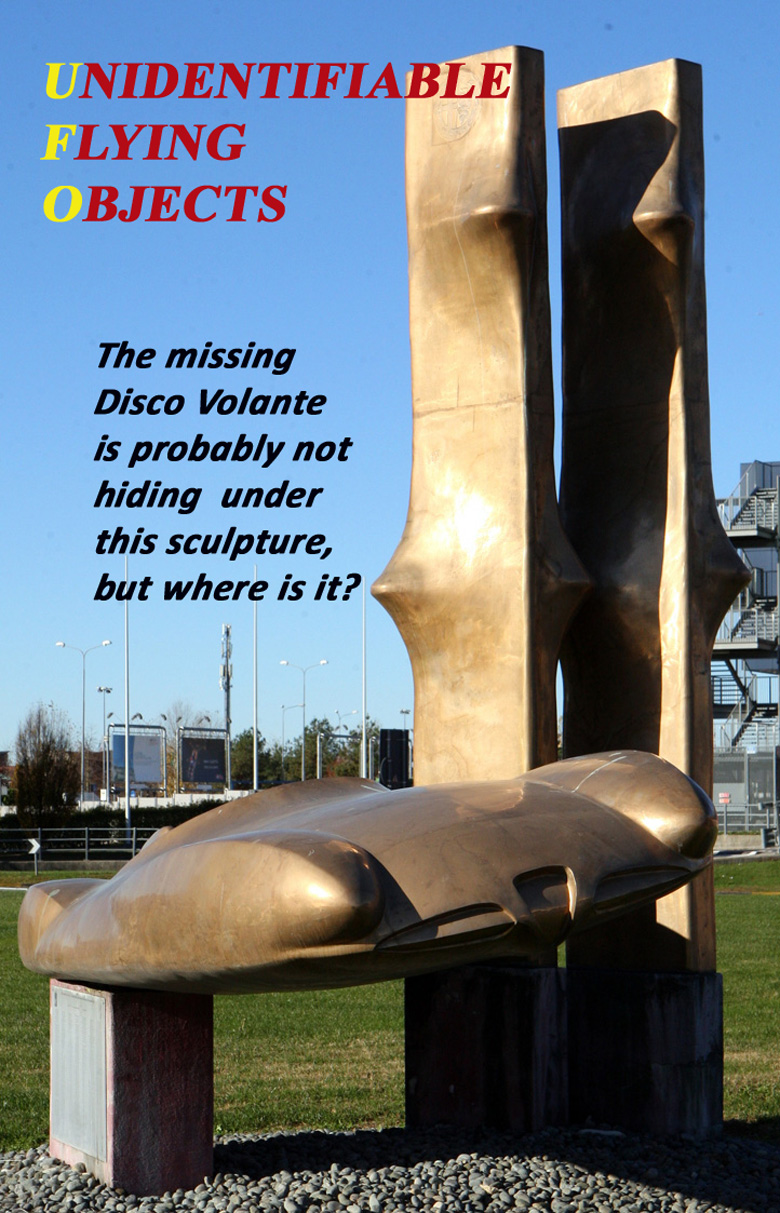
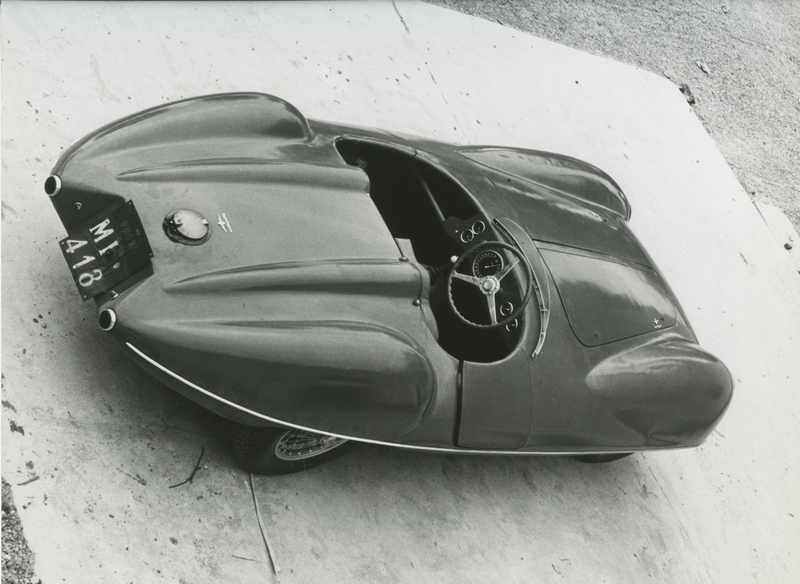
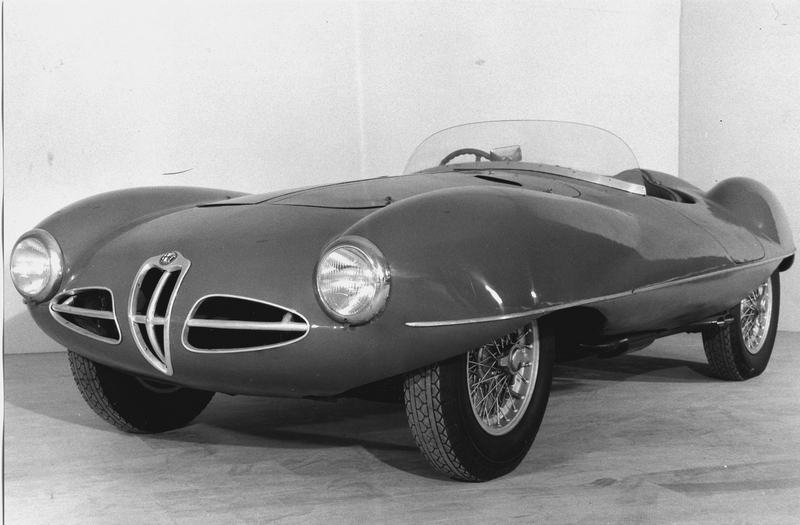
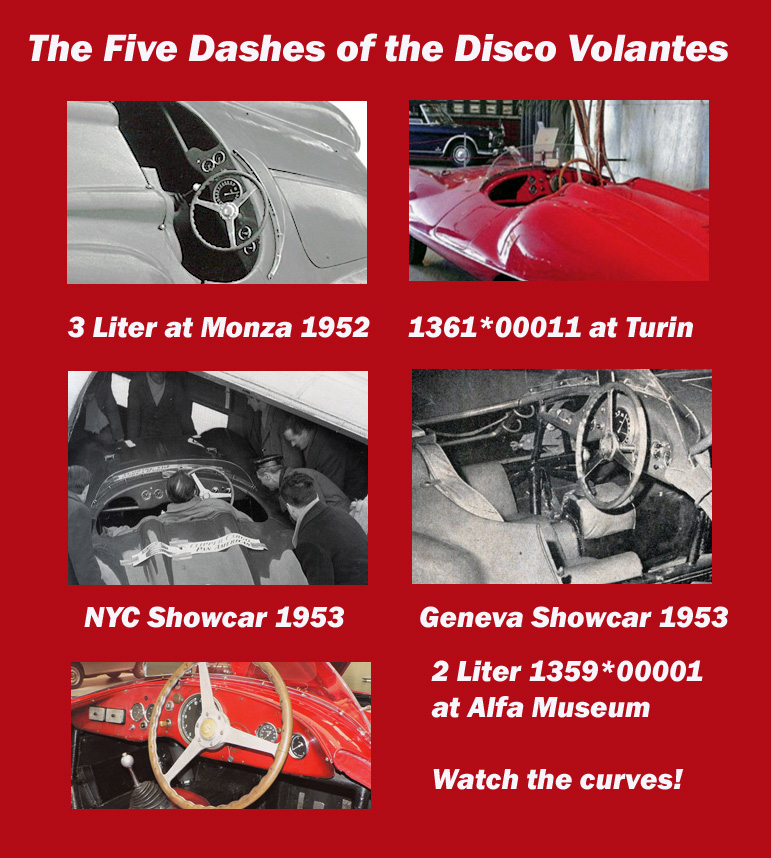
How delightfully Alfa/Italian.
A great story, Pete, and a marvelous mystery.
Regarding the car in the Monza test, if you note the spacing of the down-sweeps of the pipes from the engine, the long spacing of the two suggests an in-line 6 cylinder engine rather than a closely grouped pair that would most likely be used on a 4 cylinder.
Yes, certainly remember all that fuss in press of the style of Disco , but curiously never raced in that form, and their 1953 coupe for Mille rather clumsy looking,
Has anybody suggested this Alfa shape might have influenced the D typo Jaguar,.?
Jim sitz
Looking closely at the Oct 2, 1952 photo it appears to me that the car on the left has a longer nose and hood and therefore would be a six cylinder car. It has the bigger headlamp trim rings, and this appears to be consistent with picture of the car testing at Monza which has the bigger trim rings, longer hood, and wide exhaust manifold spacing of the six cylinder.
Years ago I saw a photo of a Disco on the back of a flat bed truck- taken in Georgia of all places. The photographer was the passenger in a vehicle that passed the flatbed and he was inquiring if anyone knew what this odd looking car was. You may or may not be familiar with this photo but it’s very interesting to think there may be a Disco lurking somewhere in the hinterlands of America.